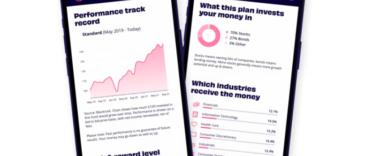 Choosing the best pension provider for you can feel like a daunting process, but it does not need to be. There are a whole host of pension providers in the UK that offer slightly different products with varying fees and charges, so there should be something for everyone.
Choosing the best pension provider for you can feel like a daunting process, but it does not need to be. There are a whole host of pension providers in the UK that offer slightly different products with varying fees and charges, so there should be something for everyone.
In this article, we break down a selection of the options to help you make a decision based on what pension is best for you. That could be finding the cheapest option, picking a pension provider with no minimum contribution or finding the pension plan that gives you the biggest choice. We also cover some of the basics of picking a personal pension plan so that you know what to look for to find the best pension in the UK for your retirement savings.
I recommend you read the article in full, however, you can jump to sections of the articles using the links below:
- Best UK pension provider comparison table
- Best UK private pension providers list
- What is a personal pension?
- How does a personal pension work?
- Which is the best personal pension provider for me?
- Steps to set up a personal pension
- Further reading
Best UK pension providers – January 2025
Below is a selection of UK pension providers that offer a variety of different types of pension plan:
| Provider | Product Types | Minimum Contribution | Service fees | Offer | Good for |
| AJ Bell* | SIPP | £0 for a regular payment,
£1,000 lump sum |
Funds:
0.25% (up to £250,000) 0.10% (£250,000-£500,000) 0% (over £500,000) Shares: 0.25% (capped at £10 per month) |
N/A | DIY and ready-made |
| Bestinvest | SIPP | £0 | DIY:
Highest of £120 per year or 0.40% (up to £250,000) 0.20% (£250,000-£500,000), 0.10% (£500,000 - £1,000,000) 0% (over £1,000,000) Ready-made portfolios: Highest of £120 per year or 0.20% (up to £250,000) 0.20% (£250,000 - £500,000) 0.10% (£500,000 - £1,000,000) 0% (over £1,000,000) |
N/A | DIY and ready-made |
| Interactive Investor* | SIPP | £25 per month | Pension Essentials plan:
£5.99 per month (Pensions value up to £50,000) Or Pension Builder plan: £12.99 per month (Pension value of £50,000 or more) |
New customers get £100 - £3,000 cashback when they deposit or transfer at least £10,000 into an Interactive Investor SIPP* before 31st January 2025. Terms & fees apply. Capital at risk. | DIY and ready-made |
| Fidelity* | SIPP | £20 per month, £800 lump sum | 0.35% or £90 if you don't have a regular savings plan (under £7,500),
0.35% (£7,500 - £250,000), 0.20% (over £250,000, capped at £2,000) |
N/A | DIY and ready-made |
| Hargreaves Lansdown* | SIPP | £25 for a regular monthly payment
£100 lump sum |
Funds:
0.45% (up to £250,000) 0.25% (£250,000 - £1,000,000) 0.10% (£1,000,000 - £2,000,000) 0% (over £2,000,000) Shares: 0.45% (capped at £200 per year) |
N/A | DIY and Ready-made |
| Nutmeg | SIPP | £500 | Actively Managed:
0.75% (up to £100,000) 0.35% (over £100,000) Fixed Allocation: 0.45% (up to £100,000) 0.25% (over £100,000) |
Management fees waived for 12 months | Ready-made |
| Moneyfarm* | SIPP | £500 | Actively Managed:
0.75% (£500 - £9,999.99), 0.70% (£10,000 - £19,999.99), 0.65% (£20,000 - £49,999.99), 0.60% (£50,000 - £99,999.99), 0.45% (£100,000 - £249,999.99), 0.40% (250,000 - £499,999.99), 0.35% (from £500,000) Fixed Allocation: 0.45% (up to £100,000) 0.35% (£100,000 - £250,000) 0.40% (£250,000 - £500,000) 0.35% (over £500,000) |
Management fees waived for 12 months* | Ready-made |
| Penfold* | SIPP | £0 | 0.75% (up to £100,000, 0.88% with Sharia account)
0.40% (over £100,000, 0.53% with Sharia account) |
N/A | Ready-made |
| PensionBee* | SIPP | £0 | Tracker Plan and Preserve Plan: 0.50% (up to £100,000),
0.25% (over £100,000) Pre-Annuity Plan: 0.7% (up to £100,000) 0.35% (over £100,000) Fossil Fuel Free Plan: 0.75% (up to £100,000) 0.375% (over £100,000) 4Plus Plan, Impact Plan and Shariah Plan: 0.95% (up to £100,000) 0.475% (over £100,000) |
N/A | Ready-made |
| Wealthify | SIPP | £50 | Standard:
0.60% (plus average fund fees of 0.16%) (up to £100,000) 0.30% (over £100,000) Ethical: 0.60% (plus average fund fees of 0.70%) (up to £100,000) 0.30% (over £100,000) |
N/A | Ready-made |
| Vanguard | SIPP | £100 for a regular ongoing payment
£500 lump sum |
0.15% (capped at £375 per year for accounts over £250,000) | N/A | DIY and Ready-made |
Best UK private pension providers
Here we break down the basics of some of the UK’s top pension providers to help you find the right pension fund for your retirement savings. You can also find a link in each section to a full review of that platform.
AJ Bell
AJ Bell is a big name in the online investment world and claims to specialise in making a personal pension plan that is simple and easy to manage. Investors can get a ready-made portfolio or opt for a plan with varying degrees of input from specialists. It is also rated as one of the best SIPP (Self Invested Personal Pension) providers on the market, with a variety of different investment options. Customers can choose from funds, unit trusts, investment trusts, ETFs (exchange traded funds), and foreign and UK shares.
AJ Bell can be a low-cost option, however, it charges for fund switches and share trading and so it can be expensive for active investors. You can manage your pension fund online or through the dedicated app. Find out more by reading our full ‘AJ Bell review’.
Bestinvest
Bestinvest offers customers a variety of different investment options, including around 2,500 funds, investment trusts, UK shares and ETFs. You can choose from three main options: pick your investments yourself, opt for a ready-made portfolio or get advice from a qualified financial planner. It is unusual for a platform to offer all three of these options. Bestinvest is also a relatively cost-effective option, though some of its ‘expert’ portfolios can prove expensive over time.
The platform is easy to use, which can make Bestinvest a good option for beginner investors looking for a wide range of options. We dig deeper into what Bestinvest can offer you in our full ‘Bestinvest review’.
Interactive Investor
Interactive Investor is an online investment service with over 400,000 customers. It charges a monthly subscription fee rather than a percentage fee, which means you will always know how much your pension pot will cost to maintain each month. Those with smaller pension pots can start with the Pension Essentials plan priced at £5.99 per month, however, it will be upgraded to the Pension Builder plan (priced at £12.99 per month) once the pension reaches a value of £50,000). Beginners are able to access Interactive Investor’s ‘Quick-start Funds’, which involve selecting from a list of six pre-prepared funds. More advanced investors can choose their own options from a host of different funds and shares.
Read more about Interactive Investor in our full review ‘Interactive Investor Review’.
Fidelity
Fidelity is an investment company with over 1 million clients in the UK. The Fidelity SIPP offers a wide range of investment options including funds, ETFs, investment trusts and shares. There is no upper limit to the amount you can invest, but there is a high minimum investment amount of £1,000. Fidelity’s fees compare well to its competitors, but the tiered system means you are most likely to get value for money if your pot exceeds £250,000. You will not need to pay any service fees on a junior pension with Fidelity.
You can read more about Fidelity in our comprehensive and independent ‘Fidelity Review’.
Hargreaves Lansdown
Hargreaves Lansdown manages around £155bn on behalf of over 1.9 million clients, making it the largest UK fund platform. Customers can access a range of guides, research and investment tools to get a better understanding of how to help their money grow. You can also choose from either a good selection of ready-made portfolios or Hargreaves Lansdown’s cash management service. Its website and app are easy to use, though it does not have a live chat support feature. You should also keep in mind that it may not always be the cheapest option.
We have much more information on how the platform could work for you in our thorough ‘Hargreaves Lansdown Review’.
Nutmeg
Nutmeg is a robo-advice platform that has been operating in the UK since 2011. It offers access to relatively low-cost fully managed portfolios made up of exchange-traded funds. In order to gauge your appetite for risk, Nutmeg asks you to grade yourself from the least risky (1) to the most risky (10). Users cannot choose their own assets and Nutmeg only invests in ETFs, but it is an easier and cheaper process than dealing with an independent financial adviser. It is unlikely to be a good match for savers looking for full control over where their money is invested.
Nutmeg customers can choose from four investment options: fully managed, fixed allocation, smart alpha and socially responsible portfolios. We examine each option in detail in our full platform ‘Nutmeg Review’. You can also read our take on its pension options in our ‘Nutmeg Pension review’.
Moneyfarm
Moneyfarm is one of the largest digital wealth managers in Europe and has been operating in the UK since 2016. Unlike other robo-advice firms, with Moneyfarm you are designated an investment consultant who can offer guidance, but not advice. The Moneyfarm Pension involves investing via a recommended portfolio based on your savings goals, your planned retirement date, the amount you want to pay in and your overall appetite for risk. Investors can choose between 7 risk based fully managed portfolios or 5 risk based fixed allocation portfolios.
You can find out how Moneyfarm calculates your appetite for risk and much more about the platform in our full, independent ‘Moneyfarm Review’.
Penfold
Penfold is a pension provider that bills itself as a flexible and inclusive alternative to other providers. You do not need to meet a minimum initial investment amount, you can complete the setup process in under five minutes and you can increase, change, or pause your payments at any time. This can be especially useful if you are self-employed or have an irregular income, and so do not want to commit to paying in a certain amount every month. You will not be able to get financial advice from Penfold, so you should be confident that you know how high your pension contributions will need to be in order to sufficiently build up your pension pot.
Find out more about getting a Penfold pension in our independent ‘Penfold pension review’.
PensionBee
PensionBee is a specialist in helping savers find their old workplace pensions and is able to provide the tools, knowledge and experience in consolidating multiple pots into one personal pension scheme. This could be extremely useful for the millions of workers who have had multiple jobs over the years, meaning they have contributed to more than one workplace pension scheme. It is worth noting that if you have paid into a defined benefit or final salary pension scheme in the past, you could end up worse off by consolidating it into a personal pension.
You can find out more and work out whether PensionBee might be a good match for you by reading our independent ‘PensionBee Review’.
Wealthify
Wealthify is another of the UK’s growing number of robo-advisor platforms. It gives customers the choice of five investment plans handily named Cautious, Tentative, Confident, Ambitious and Adventurous. You can choose the one that best matches your risk profile, with the added bonus of an ethical investment option for each plan. This is a great extra for savers looking to make sure that their investments match their position on issues like environmental damage.
Wealthify fees vary depending on which option you choose and how much you invest, plus the annual platform fee of 0.60% up to £100,000 and 0.30% for any portion above that. You can find out more by reading our full ‘Wealthify Review’.
Vanguard
Vanguard is an investment platform that is owned by the funds that customers invest in, which can mean that there is a greater focus on investor outcomes than shareholder profits. It gives investors the choice of building up their pension pot through selecting a ready-made product or building their own portfolio from over 75 own-brand funds. These include ETFs, active funds and index funds, but Vanguard does not offer stocks and shares.
You will need to pay in at least £100 a month and any lump sums will need to be £500 or more, which could be a red flag for savers looking for flexibility. You can find out if Vanguard would suit you by reading our article ‘Vanguard SIPP review: Is it the best low-cost Pension?’.
What is a personal pension?
A personal pension is a financial product set up by an individual with the intention of using the funds to finance their income in retirement. It is funded through regular contributions – usually a percentage of your income every month – or irregular lump sums. The money is invested with the intention of growing your pension pot over the course of your working life. With a personal pension, you can choose to invest your money in specific ways or opt to have your pension provider make the investment decisions for you.
Personal pensions differ from workplace pensions because you will need to select the provider yourself and set up the payments directly, rather than your employer doing it for you. Another significant difference is that you will not gain from employer contributions, which you would do with a workplace pension. However, you can still profit from tax relief from the government. Personal pensions benefit from added flexibility compared to workplace pensions, but both will likely be ‘defined contribution’. This means that your retirement income will be based mostly on the value of your pension pot, rather than your final salary.
Both personal pensions and workplace pensions are types of private pensions, which are different to the State Pension. The State Pension is a government benefit that can be claimed by people over the qualifying age who have made enough National Insurance Contributions (NICs). You can read more about the 2024/25 State Pension in our article ‘How much is the UK State Pension?’.
There is more information on the basics of private pensions in our article ‘How do private pensions work?’.
How does a personal pension work?
A personal pension is a type of private pension. Unlike with a workplace pension, you will need to do a bit of legwork in order to set up a personal pension. You choose the provider yourself, decide how much you want to pay in and arrange the payments.
It can be easier to adjust your monthly payments into a personal pension than into your workplace pension. You can also make contributions in irregular lump sums, which you cannot easily do with a workplace pension.
Personal pensions are almost always defined contribution, which means that your retirement income will be based on the value and performance of your pension pot. This can mean you end up with a lower income than if you had a defined benefit workplace pension, though these are now quite rare anyway.
Read more on how to manage your personal and workplace pensions in our article ‘Can I have a personal pension and a workplace pension?’.
With a personal pension, you have the flexibility to invest in the funds that you think will perform best or are most important to you. Alternatively, you could choose a product that makes most of the big decisions for you. You can still benefit from tax relief on contributions into a personal pension, as you would with a workplace pension.
Once you reach retirement age, you have a few different options to try and make the most of your pension pot. You can withdraw part of your pension pot as a tax free lump sum, opt for a drawdown pension or purchase an annuity. We go into more detail on what to do with your pension once you stop working in our article ‘Can I withdraw my pension?’.
Which is the best personal pension provider for me?
The best provider for you will depend on which features are most important to you. If you are concerned about fees eroding the value of your pension pot, you may find that the cheapest provider is the best provider. The range of available investments might be important to you, especially if you only want to invest in ethical funds. This could draw you to a provider that specialises in the kind of investments you want to make, or at least gives you the freedom to pick and choose where your money goes.
Some savers will be desperate to avoid the admin and decision-making that comes with a private pension. This group could be best suited to a robo-managed pension or one that comes with pre-selected funds to invest in. These pension providers could also be a good fit for savers with little investment experience, or who feel they don’t have the right skills.
You can find out more about what type of pension the major providers specialise in by reading our comprehensive reviews.
Steps to set up a personal pension
You will need to open your personal pension yourself. Here are the key steps to follow:
- Choose your provider - There are a range of different pension providers in the UK that offer a variety of products. Making your choice can boil down to how many decisions you want to make and how much you are happy to pay in fees, but there are also a lot of other factors to consider. You can opt for the plan that gives you the most flexibility, one that makes it easy to implement your own decisions, or one that takes care of all the decision making for you. Alternatively, you could simply go for the cheapest option, or the one that you think offers the best value for money.
- Transfer your existing pensions, or not - You can choose to leave any old workplace or personal pensions where they are, or you could combine all of your existing pension pots into your new one.
- Set up regular payments - The most efficient way to fund your personal pension is usually through making regular monthly payments. You can do this easily by setting up a direct debit to coincide with payday, but it might not suit everyone. If you have an inconsistent income, you might choose to pay in irregular lump sums instead.
- Watch your money grow - You can usually use your pension provider’s online dashboard to check in on how your funds or pots are performing. You could then make changes by adjusting your risk level or switching to a different fund, depending on the type of pension product you are using.
Further reading
- What is the State Pension triple lock?
- Can I withdraw my pension?
- How do private pensions work?
- Can I have a personal pension and a workplace pension?
- What is the best way to combine my pensions?
- How much is the UK State Pension?
- How to find old pensions?
- The best & cheapest SIPPs – build a low cost DIY pension
- Best and cheapest Junior SIPPs
- How to transfer your pension – everything you need to know
- The Cheapest SIPP – the best value pension for you
If a link has an * beside it this means that it is an affiliated link. If you go via the link, Money to the Masses may receive a small fee which helps keep Money to the Masses free to use. The following links can be used if you do not wish to help Money to the Masses or take advantage of any exclusive offers - Hargreaves Lansdown, Interactive Investor, AJ Bell, Moneyfarm, Fidelity, Pensionbee, Penfold







